 The rooster is the French national bird, an unofficial symbol of Gallic pride, virility and, well, cockiness. Does this make coq au vin the French national dish? Not necessarily, although it’s certainly a contender. Coq au vin is most often associated with Burgundy, although other regions — notably the Auvergne — also lay claim. Rustic fare, coq au vin has existed in one form or another for centuries. In the modern version, you may substitute a big free-range or organic chicken if a good rooster proves hard to find.
The rooster is the French national bird, an unofficial symbol of Gallic pride, virility and, well, cockiness. Does this make coq au vin the French national dish? Not necessarily, although it’s certainly a contender. Coq au vin is most often associated with Burgundy, although other regions — notably the Auvergne — also lay claim. Rustic fare, coq au vin has existed in one form or another for centuries. In the modern version, you may substitute a big free-range or organic chicken if a good rooster proves hard to find.
Some food historians date the creation of coq au vin back as far as Caesar’s conquest of Gaul. There may be something to this, for the Latin word gallus signifies both ‘rooster’ and ‘Gallic’. And indeed, if you look around in France, you will see roosters everywhere. In Burgundy, for example, not a cross but a rooster sits proudly on each church’s steeple.
I am offering you this superlative French dish in a spirit of celebration — in time for the holidays and in thanks for your interest and support. As of this week, The Everyday French Chef has received more than 10,000 views. I am very grateful to all my readers for supporting the site and giving me the opportunity to continue writing about two of my great pleasures in life — food and France. Happy cooking!

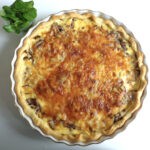 One of the things I find most amazing about cooking is the way the simplest of ingredients can be turned into a dish that is, frankly, sublime. Red onion tart is such a dish. The onions are gently sautéed with a pinch of thyme, then placed in the tenderest of savory pie shells, sprinkled with cheese, bathed in a mixture of egg, milk and cream, salted, peppered and sprinkled with nutmeg. And all it takes to prepare this creation is one red onion.
One of the things I find most amazing about cooking is the way the simplest of ingredients can be turned into a dish that is, frankly, sublime. Red onion tart is such a dish. The onions are gently sautéed with a pinch of thyme, then placed in the tenderest of savory pie shells, sprinkled with cheese, bathed in a mixture of egg, milk and cream, salted, peppered and sprinkled with nutmeg. And all it takes to prepare this creation is one red onion.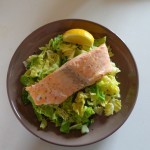


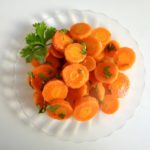 Does North African cooking count as French cuisine? I had dinner a couple nights ago with friends who insist that it does. ‘After all,’ said Jack, ‘when the French are asked to name their favorite food, the dish that comes up most often is couscous.’ And indeed, the influences back and forth between France and its former colonies are so strong that North African cuisine can be found virtually around every corner here. This Moroccan carrot salad — fresh, flavorful and oh so spicy — will transport you to a hot and exotic land.
Does North African cooking count as French cuisine? I had dinner a couple nights ago with friends who insist that it does. ‘After all,’ said Jack, ‘when the French are asked to name their favorite food, the dish that comes up most often is couscous.’ And indeed, the influences back and forth between France and its former colonies are so strong that North African cuisine can be found virtually around every corner here. This Moroccan carrot salad — fresh, flavorful and oh so spicy — will transport you to a hot and exotic land.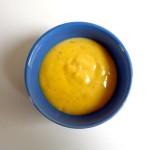 Let’s demystify mayonnaise — one of France’s most versatile and elegant sauces. It is reputedly so difficult to make that only culinary experts should attempt it. Guess what The Everyday French Chef has to say to that? Poppycock. If you have the ingredients on hand, you can whip up a bowlful in less than five minutes. And the results are spectacular. Once you’ve tried it, you may find yourself singing, ‘Ain’t nothin’ like the real thing, baby, nothin’ like the real thing…’
Let’s demystify mayonnaise — one of France’s most versatile and elegant sauces. It is reputedly so difficult to make that only culinary experts should attempt it. Guess what The Everyday French Chef has to say to that? Poppycock. If you have the ingredients on hand, you can whip up a bowlful in less than five minutes. And the results are spectacular. Once you’ve tried it, you may find yourself singing, ‘Ain’t nothin’ like the real thing, baby, nothin’ like the real thing…’ 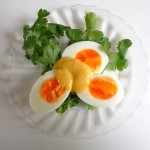
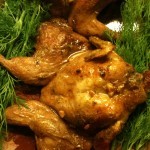

 I first tasted this dish in the home of Valérie Lapierre, a superlative cook. She and another friend, an artist, had concocted a fabulous meal but refused to say what the main course would be. And then they arrived bearing dinner plates, each with its own small stuffed pumpkin. The pumpkins’ caps were lifted. An amazing aroma escaped. Spoons were dipped in. Out came succulent baked pumpkin and a filling of mushrooms, onions and cheese. It was one of the best things I’ve ever tasted, and quintessentially French.
I first tasted this dish in the home of Valérie Lapierre, a superlative cook. She and another friend, an artist, had concocted a fabulous meal but refused to say what the main course would be. And then they arrived bearing dinner plates, each with its own small stuffed pumpkin. The pumpkins’ caps were lifted. An amazing aroma escaped. Spoons were dipped in. Out came succulent baked pumpkin and a filling of mushrooms, onions and cheese. It was one of the best things I’ve ever tasted, and quintessentially French.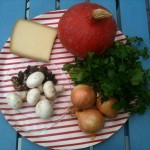
 This is a cold-weather dish most commonly encountered in the Alpine ski resorts of eastern France: potatoes, onions, bacon and flavorful reblochon cheese baked together to make a mouth-watering one-dish meal. But tartiflette has become so popular that restaurants from Burgundy to the Pyrenees now serve it. The name derives from a word for potatoes, tartifla, that is used in Italy and Provence — but, oddly, not in Savoie…
This is a cold-weather dish most commonly encountered in the Alpine ski resorts of eastern France: potatoes, onions, bacon and flavorful reblochon cheese baked together to make a mouth-watering one-dish meal. But tartiflette has become so popular that restaurants from Burgundy to the Pyrenees now serve it. The name derives from a word for potatoes, tartifla, that is used in Italy and Provence — but, oddly, not in Savoie…

